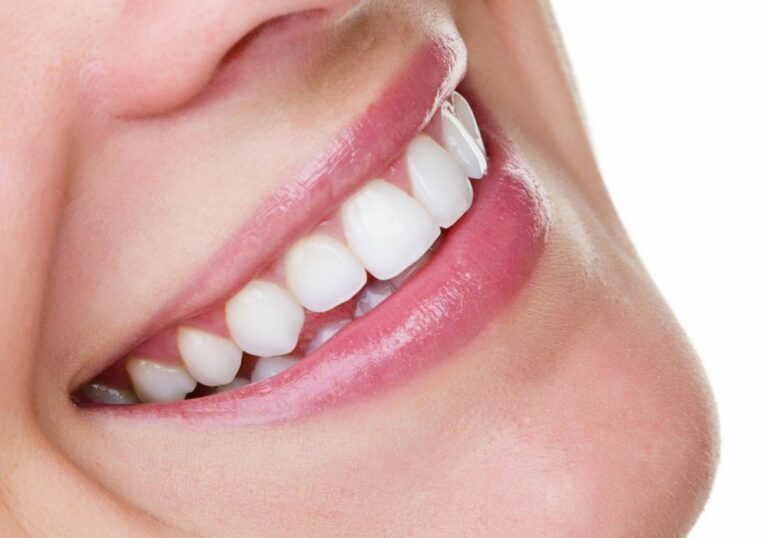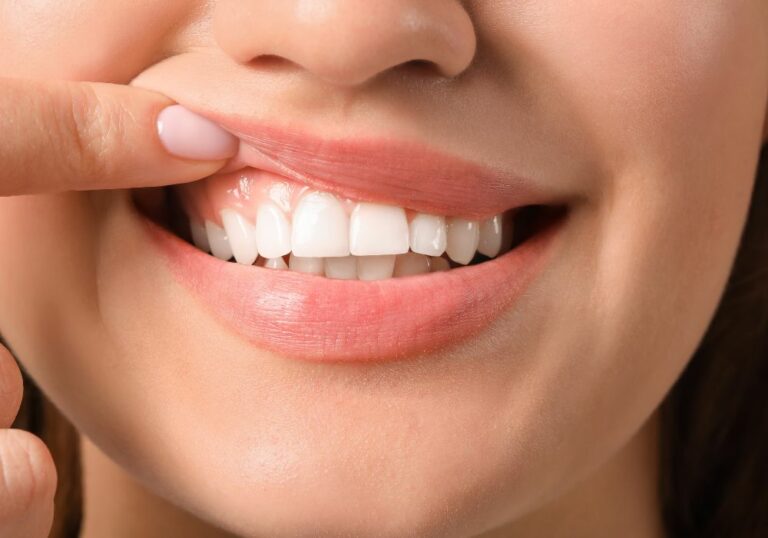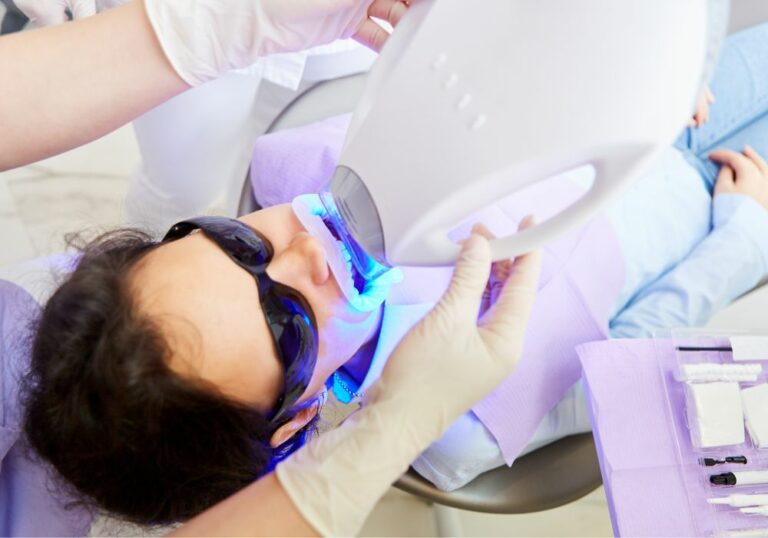Vaping has exploded in popularity over the past decade, especially among teenagers and young adults. The trendy tech gadgets come in sleek designs. Users inhale flavored vapor instead of smoke. Many believe vaping provides a healthier alternative to cigarettes. But is that truly the case?
While vaping eliminates many of the carcinogens found in cigarette smoke, new research shows it comes with its own set of oral health risks. The toxic chemicals and extreme heat from vaping can damage teeth and gums in several ways. Dentists are now on the lookout for signs of vaping damage during routine exams. But can Dentists tell if you vape just by looking inside their mouths?
How Vaping Affects Oral Health?
The oral cavity endures significant exposure with vaping. Users inhale vapor directly into their mouths multiple times per vaping session. Teeth bear the brunt of this repeated heat and chemical exposure.
Here are some of the most prominent ways vaping jeopardizes oral health:
Accelerated Tooth Decay
The glycerin and propylene glycol common to most e-liquids are hygroscopic. This means they attract and absorb moisture out of the air – and your mouth. Chronic vaping can lead to severely dry mouth by limiting saliva flow.
Saliva plays a critical role in protecting and maintaining tooth integrity. It washes away food debris and neutralizes the acids produced by oral bacteria. Saliva also replenishes minerals like calcium and phosphate that strengthen enamel.
With less saliva present in the mouth, vaping tips the balance in favor of tooth decay. Bacteria thrive and release enamel-eroding acids. Minerals cannot get replenished. Food and drink particles stick to tooth surfaces longer. It provides the perfect storm for extensive cavities.
Multiple studies have confirmed the link between vaping and increased tooth decay. One examined oral health markers in young adult smokers vs vapers vs non-users. The vapers showed significantly higher levels of streptococcus mutans, the bacteria responsible for most cavities. Their mouth environment also demonstrated heightened acidity compared to non-vapers.
Another study surveyed 2,663 adolescents about their vaping habits and oral health. Teens who vaped had nearly twice the incidence of cavities compared to their non-vaping peers. Their decay rates exceeded even those who smoked traditional cigarettes.
With decreased saliva flow, increased bacteria, and constant acid attacks, the cavities can develop and spread rapidly. Vaping appears to accelerate the decay process beyond even that from poor hygiene.
Enamel Erosion
Heat and inhaled toxins also weaken and erode tooth enamel. Enamel comprises over 95% of the visible tooth crown. Although very durable, enamel cannot regenerate or repair itself once damaged.
Researchers recently analyzed and compared the tooth enamel from longtime vapers, smokers, and non-users. The vapers showed significantly higher rates of enamel erosion and surface wear than the control groups. Close inspection revealed delicate, spiderweb-like cracks along the enamel surface. This occurred even among vapers with good oral hygiene.
The investigators concluded that thermal degradation and chemical additives found in vaping vapor contribute heavily to the enamel damage. They estimated the enamel loss rate for vapers to be around 55% higher than for non-vaping individuals.
The loss of protective enamel opens the inner tooth layers to increased sensitivity. It also accelerates decay by exposing more porous dentin and brittle cementum to bacteria and acid attacks. Once enamel erodes, there is no way to get it back.
Gum Recession and Disease
Vaping appears to impact not just the teeth but the soft tissues supporting them. Studies find vapor chemicals increase inflammation markers within gum tissue. The heat also causes irritation.
Inflamed, irritated gums tend to recede or detach from the teeth. This exposes sensitive root surfaces to the acids and bacteria described earlier. It leaves them unprotected and prone to severe decay. Exposed roots also increase overall tooth sensitivity and discomfort when eating or drinking hot or cold foods.
Gum disease also runs rampant with reduced saliva flow and higher oral bacteria counts. Bleeding and tender gums indicate gingivitis, or early stage gum disease. Without proper treatment, gingivitis can progress to advanced periodontitis and eventual tooth loss.
One study published in the Journal of Periodontology looked at rats exposed to propylene glycol vapor. Within weeks, the rats developed inflamed gums with damage to the periodontal ligaments. They also showed overgrowth of osteoclasts, cells that break down bone tissue. The effects mirrored the development of periodontitis in humans.
In addition to inflamed, receding gums, dentists also look for telltale signs of vaping like calluses or irritation at the corners of the mouth. These lesions stem from repeated rubbing against vaping equipment.
Increased Tooth Staining and Discoloration
The chemicals and coloring agents in vaping liquids can stain teeth significant shades of yellow to brown. Many e-juices contain food dyes and chemicals like furfuryl and vanillin that cling tenaciously to tooth enamel. Even clear e-liquids can discolor from accumulation of tartar and debris.
Stained teeth affect personal appearance but mostly represent a cosmetic issue. However, dark vape stains could potentially mask early decay triggered by the other mechanisms above. By the time dentists detect cavities from looking alone, they may require more complex treatments. This emphasizes the importance of thorough dental exams for vapers.
Cracked and Broken Teeth
Clenching down repeatedly on a vape mouthpiece transmits concentrated force to a small area of the teeth. Much like chewing ice or popcorn kernels results in cracks, vaping can stress certain teeth enough to cause fractures.
Cracked teeth become highly sensitive and prone to serious decay if the fracture reaches the pulp. Bacteria and acids rapidly infiltrate deep into the tooth through the break. Left untreated, fractures enable rampant decay that require root canals or extractions to remedy.
Safety Concerns with DIY E-Liquid Ingredients
A final oral health concern applies mainly to vapers who mix their own e-liquids. Some DIYers use unsafe oils, solvents, and chemicals to concoct homemade vaping juices.
Ingredients like vitamin E acetate and mineral oil can cause severe lipoid pneumonia if inhaled. Other chemicals like formaldehyde used irresponsibly create known carcinogens. These pose risks not just for the lungs but the mouth and throat when vaped.
So in addition to recognized hazards of commercial vaping, dentists must watch for damage from caustic chemicals found in shady DIY e-juices.
Clues and Signs Dentists Notice
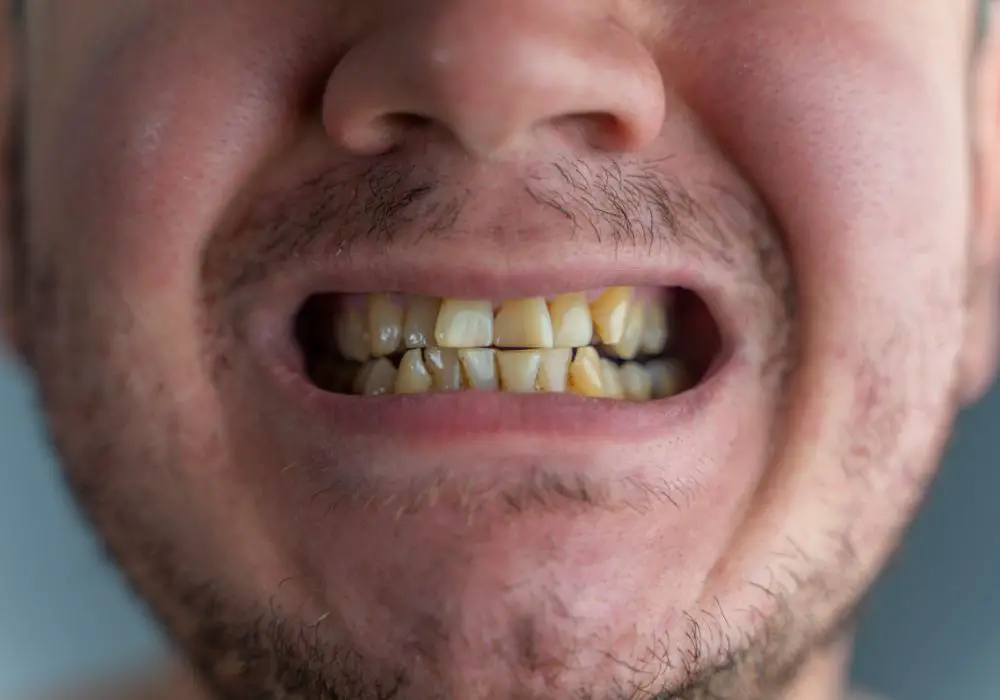
It takes a keen, trained eye to recognize subtle early signs of vaping damage versus normal wear and tear. But as vaping-related issues increase, dentists can piece together evidence for a probable vaping habit:
- Increased cavities, especially along the gum line
- Receding inflamed gums with exposed roots
- Visibly eroded or cracked enamel
- Discoloration and tooth staining
- Calluses at the corners of the mouth
- Dry mouth with decreased saliva flow
More advanced decay requires x-rays to confirm, but dentists also notice some early warning flags like:
- Slight darkening and yellowing at the tooth edges nearest the gums
- Thin white lines following gum contours indicating enamel erosion
- Small cracks or craze lines in enamel that could lead to fractures
Dentists also associate common lifestyle factors with a higher likelihood of vaping:
- Younger patients from teenage years through 30s
- Heavy caffeine or alcohol consumption
- Stress or anxiety
- Lack of regular dental care
Of course, none of these signs automatically mean someone vapes. But certain patterns together can raise suspicion, especially if gum recession and fractures occur rapidly.
For example, consider a 22 year-old patient with otherwise good hygiene who suddenly develops two fractured molars and sensitivity. Their gums appear irritated with some recession around the molar roots.
The patient admits to high caffeine intake and infrequent dental visits. While not definitive, these symptoms would prompt questions about vaping habits and further investigation.
Advanced Screening Technology
In addition to visual and radiographic examination of the teeth and gums, some dentists employ supplemental technology to identify vaping damage:
- Transillumination – A bright light shone against the back of a tooth highlights cracks and decay close to the pulp that might otherwise get missed.
- DIAGNOdent – This laser fluorescence detector illuminates enamel weakness and demineralization from erosion and caries. It helps detect vaping-associated decay in its earliest stages.
- Electronic caries monitor – Sensors detect cavitation within enamel based on electrical resistance. Useful for discovering small or hidden decay spots.
- Plaque visualization – Disclosants and dyes illuminate plaque buildup on teeth, indicating areas prone to acid attacks from bacteria.
- Chemical odor sensors – Advanced units like the Solmetex can detect even faint traces of chemicals that indicate vaping.
- Cotinine saliva tests – Screening saliva samples for cotinine, a metabolite of nicotine, provides evidence of nicotine vaping.
- Intraoral cameras – Extreme close-up photos and videos relay the fine damage of erosion, recession, and fractures.
With such in-depth analysis, dentists have multiple ways to substantiate vaping as the likely cause of various oral issues. But the most reliable confirmation comes from patients honestly discussing their vaping habits with their dentist during examinations.
Patient Communication is Key
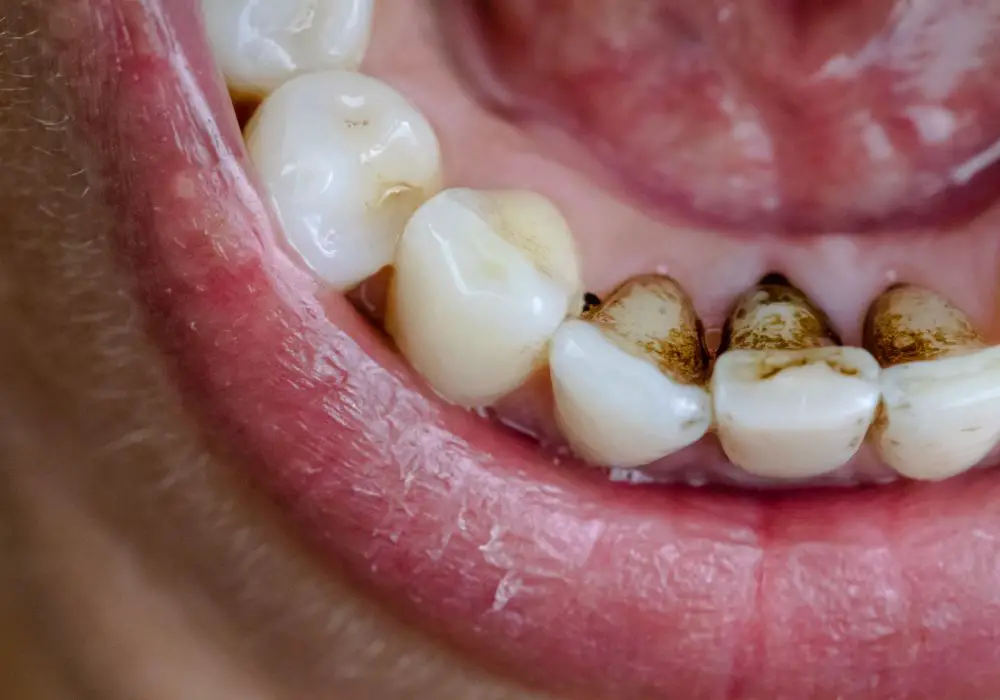
Since direct visual cues can be subtle and unreliable by themselves, dentists rely heavily on what patients disclose about their lifestyle. They can then offer the appropriate guidance and preventive care.
An open discussion about vaping lets dentists properly assess risks and look for specific problems. Patients have nothing to fear or hide. Dentists avoid judgment and simply want to provide the best treatment tailored to each patient’s situation.
With younger patients, dentists tread sensitively to keep communication open. Demonizing or scolding them about vaping often shuts down dialog and progress.
Instead, dentists focus on education and harm reduction – encouraging patients to cut back on vaping and take steps to strengthen teeth against its effects. Small improvements like vaping less frequently and swishing water after use make a big difference.
Patients also learn that even if vaping caused some irreversible damage, ways exist to halt and prevent further progression. But catching issues in the early stages remains critical.
Can Vaping Oral Damage Be Reversed?
The prognosis depends on the severity of damage and how quickly it gets identified and treated. Mild conditions often resolve fully but advanced decay and trauma require extensive restoration.
Remediating Early Damage
By taking action promptly when symptoms first arise, patients can achieve the best outcome. Early stage problems like mild sensitivity and demineralization respond well to these interventions:
- Fluoride – High concentration fluoride applied professionally or using daily rinses remineralizes weakened enamel and prevents cavities.
- Oral hygiene – Consistent, thorough brushing and flossing removes staining and food debris that cause decay. Using antibacterial mouthwash reduces acid-producing oral bacteria.
- Gum therapy – Non-surgical cleanings scrape away built-up calculus that drives gum recession. Medicated chip treatments reduce inflammation.
- Saliva substitutes – Artificial saliva products enhance moisture levels and neutralize damaging acids.
- Dental fillings and sealants – Applying protective sealants to pits and fissures prevents cavities. Minor decay gets filled before it reaches the pulp.
By curtailing vaping use and reinforcing good daily habits, patients often successfully stabilize and strengthen teeth in the short-term. But tooth structure lost to enamel erosion cannot be restored conservatively.
Managing Advanced Cases
If vaping-related damage advances untreated due to delayed evaluation and intervention, more complex solutions become necessary.
Extensive decay penetrating deep into the tooth requires root canal therapy to save the tooth. The pulp and nerves get removed and replaced with synthetic filler. An artificial crown gets placed for protection.
Severely fractured teeth also receive crowns to prevent further cracking. Porcelain or ceramic crowns withstand biting forces better than damaged natural enamel.
For gums receding excessively from inflammation and abrasion, soft tissue grafts prove effective. Grafting involves taking a small flap of tissue from the roof of the mouth or donor site and securing it over exposed roots. This protects them and covers some recession.
However, advanced gum disease with significant bone loss may still lead to eventual tooth loss. Fortunately, dentists try other options first like laser therapy to stimulate regeneration and anti-infective irrigations.
With early detection and care, cases without irreversible pulp or bone damage generally stabilize. But delaying treatment limits what dentists can salvage.
Steps Patients Can Take
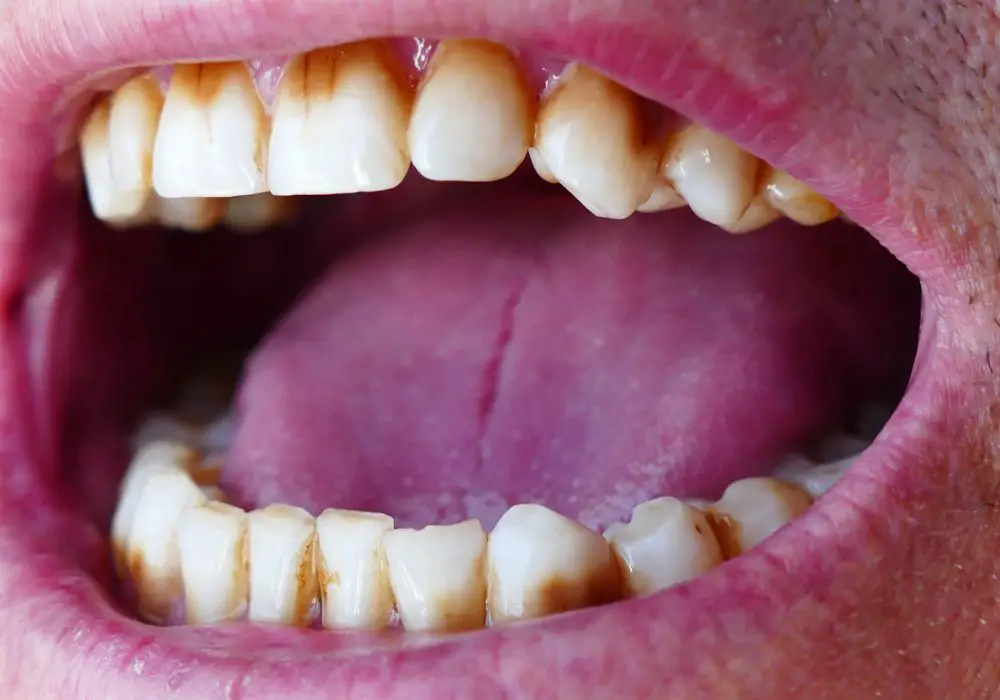
Dentists always advise patients aim for prevention first with vaping damage. Once teeth fracture and decay, restoring them fully proves near impossible. Taking these proactive measures helps minimize oral risks:
- Drink more water – Proper hydration stimulates saliva flow to buffer acids and wash away debris.
- Limit vaping frequency – Don’t vape all day long. Designate time for meals and oral care.
- Choose less sugary e-liquids – Sugar feeds the bacteria that start the decay process.
- Brush thoroughly after vaping – Removing residue prevents it from settling on teeth.
- Floss around crowns – Debris gets trapped easily under crowns and causes decay.
- Rinse with antibacterial mouthwash – Reducing oral bacteria reduces acid production.
- Apply fluoride treatments – Fluoride remineralizes enamel and prevents cavities.
- Get cleanings every 6 months – Regular visits allow early detection and care.
- Avoid snacking between vaping – Constant food exposure worsens decay.
- See the dentist at any sign of problems – Small issues get bigger without care.
- Consider quitting – Eliminating vaping altogether minimizes the risks.
Following these simple measures religiously makes a huge difference in saving teeth and gums. Committing to improvements early on helps avoid extensive repairs later.
The Bottom Line
While vaping exposes the mouth to fewer carcinogens than cigarette smoking, emerging research indicates it poses many underappreciated threats to oral health. From enamel erosion to gum disease, vaping can rapidly instigate tooth decay and tissue damage in just weeks or months.
Luckily, dentists have gotten better at identifying telltale signs of vaping damage during routine exams. Technology gives them added ability to detect early changes. This allows for earlier intervention and prevention – especially if patients are open about their vaping habits.
The prognosis depends greatly on how soon dentists can detect issues and how cooperative patients are implementing preventive care. Moderate vaping, maintaining excellent oral hygiene, and professional care helps curtail damage and preserve teeth for the long run.
So be proactive by discussing vaping use with your dentist so they can properly assess your risks. With their guidance, you can continue enjoying vaping with greatly reduced likelihood of dental disasters.
Frequently Asked Questions
Q: How soon could my teeth show signs of vaping damage?
A: Because vaping exposes teeth repeatedly to heat, chemicals, and acids, enamel erosion and sensitivity can develop within just weeks or months of frequent e-cig use. Staining may also accumulate rapidly.
Q: Can special toothpastes help clean vaping stains?
A: While some toothpastes and rinses claim to remove vaping discoloration, results are hit or miss according to reviews. Often the set-in stains require professional cleaning. But ask your dentist before trying any abrasive whitening pastes that could wear down enamel.
Q: Is vaping damage still obvious years after I quit?
A: Years of chronic vaping can cause permanent issues dentists notice long after quitting, like worn enamel, receding gums, and old discoloration. Without new damage occurring, remaining teeth have a chance to recover. But existing enamel loss cannot get reversed.
Q: Will my dental records show evidence of vaping damage?
A: Yes, vaping-related problems like excessive decay and eroded enamel leave permanent marks in dental records. Dentists document observed damage and any restorative treatments performed. Years later, your history would reflect clear signs of past vaping damage.
Q: If I’m under 18, do dentists have to tell my parents they found vaping damage?
A: For minor patients, dentists usually recommend being truthful to parents about found vaping damage. However, legally they cannot disclose confidential medical findings without the patient’s consent. Dentists instead focus on education and preventive care for young vapers.


